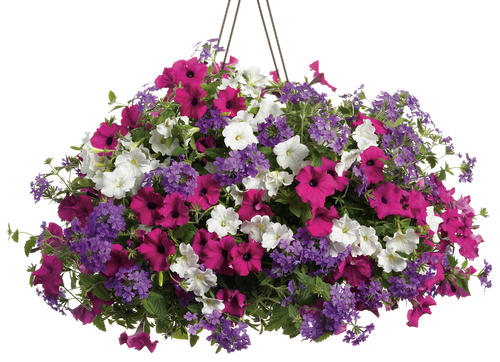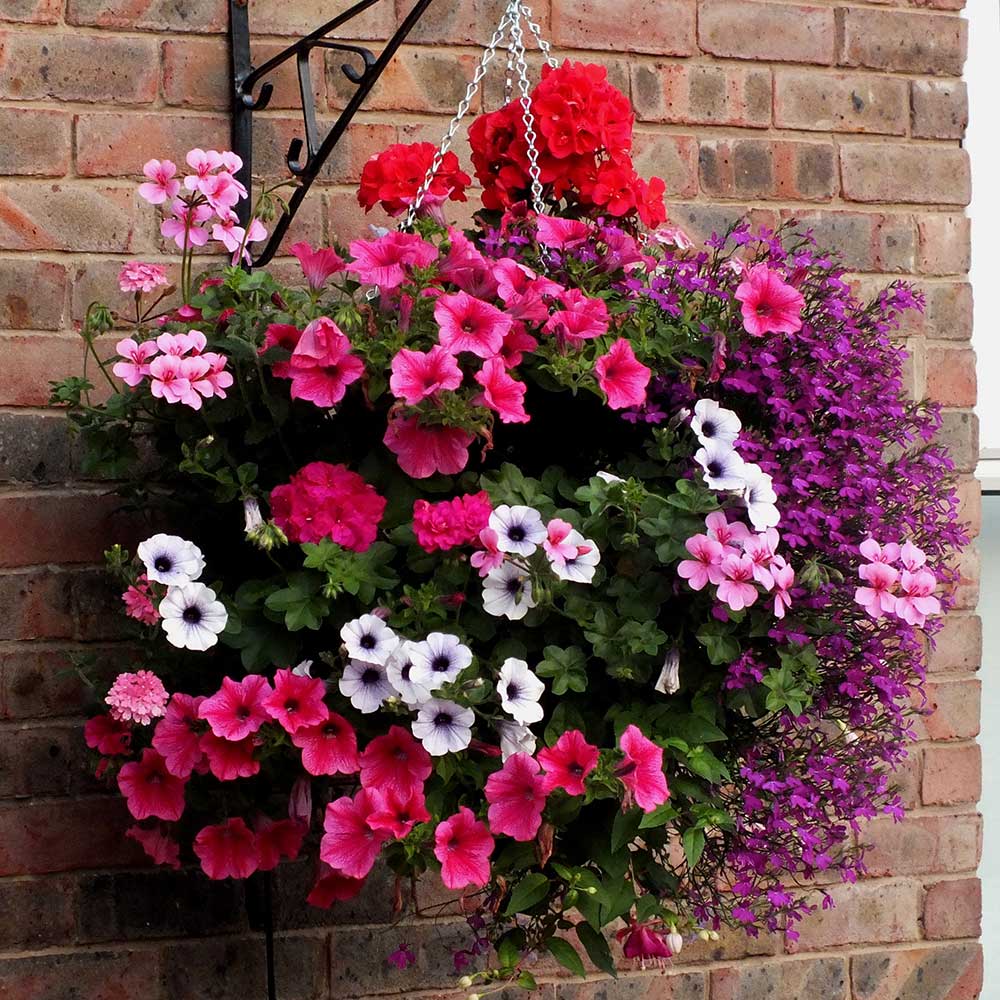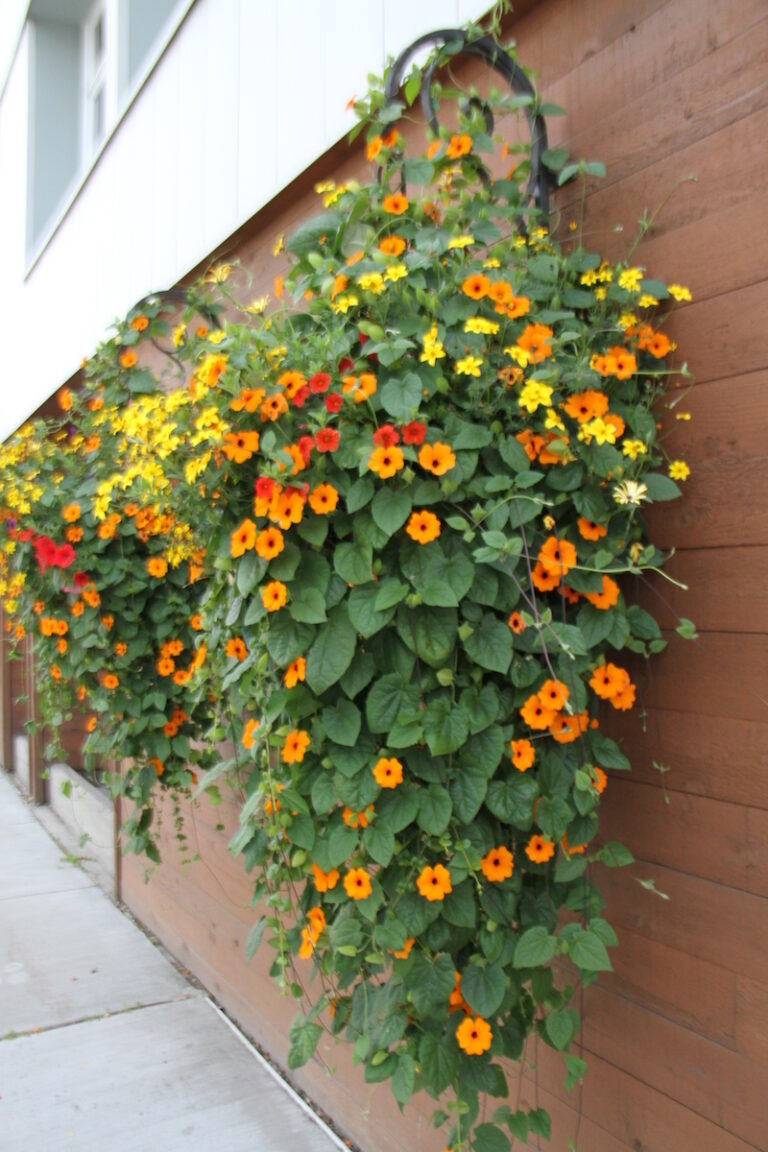
If you want to create a piece of ‘Absolutely Fabulous’, hanging baskets are the one for you. Done successfully, they are a feast for the eyes, a striking sizzling summer statement of real glamour and beauty, imbued with a sense of majesty and even fairytale magic. But most importantly it is all about having a whole lot of fun. The only limits are the degree of your own boundless enthusiasm and imagination.
Maybe there is Christmas coming up, a future wedding or a grand birthday celebration perhaps, or even a competition for the best hanging baskets at the inaugural New England Garden Festival this coming November.
Quite often planted hanging baskets start out all well enough, however if initially poorly prepared with not enough love and attention, they slowly deteriorate in health and at the height of summer, just in time for Christmas, a whole lot of ugly sets in and past great intentions shrivel to a crisp.
To create a surefire perfect pizzaz of a hanging basket all you need is to follow five pieces of advice. This blog may well be a lengthy one for some, however there is a lot of information to be learnt and absorbed, to get it all just right and as perfect as possible. Then just go for it, all plants and hanging baskets a blazing.
1. The Basket
The great issue with hanging baskets is their ability to retain moisture and subsequently their frequency of watering to maintain their health and vitality. You have two alternatives, plastic or cocoa fiber matting in open wire frames.
The advantage of plastic pots is that the material and its accompanying fitted saucer hold their moisture well, thus less watering and easier case of maintenance. Because of this, plastic pots are the only type of hanging pot filled with flowers or any plants available for sale in retail nurseries. The disadvantage is you cannot make holes below the rims circumference to add any further plants and the basket may well still be visible even when the plantings are mature.
Open wire baskets with coconut fiber matting, though so very aesthetically pleasing, just bleed water, and quickly the potting mix and the matting will shrink in upon itself and become hydrophobic and near to useless. The only remedy for this is the addition of an inner lining of plastic, to conserve water and keep the soil moist, much like a plastic basket. Their great advantage is that you can make cuts in the basket’s cocoa material to add further plants and hide the basket surface.
Importantly, the size of basket does count, the bigger the basket the better. A minimum of 45cm in width is perfect. You have a larger soil mass to retain water and the opportunity to grow even more plants to make it all more visually appealing.

2. The Potting Mix
The best quality potting mix is essential. Please don’t be a skint or miser with this. Nothing is as important for ensuring either future grand success or quick dismal failure. Inferior potting mix is simply cheap crap, comprised of nothing but wood, sand and sawdust without a trace of any fertilisers, far more appropriate to desert plantings, and are not worth the plastic they are wrapped and bagged in. A great quality potting mix will contain much better and longer composted materials, enriched with a mix of well-balanced fertilisers, trace elements and wetting agents all guaranteed for a minimum of six months.
I also further improve the quality of the basket’s potting mix by adding a generous couple of handfuls of Seamungus, peat moss and more water crystals. The Seamungus promotes greater root development by at least 50%, greater resistance to stress and disease and the overall health of plant. The peat moss and wetting agents will further contribute and elongate the potting mixes future water retention abilities.
3. The Design
Pick your colour tones, maybe hot, rich and exotic, or soft and subtle pastels. Whatever you choose the inclusion of white is mandatory for two reasons. Firstly, in the evening as the sun falls, when you may be relaxing, even entertaining, white is the only solitary colour which will be visible and thus appreciated. Secondly in our hot summer sun, the colour pigments of pinks, blues and purples are simply washed and bleached away. But with the addition of accompanying white flowers their lost rich pigments are reinstated becoming again crisp and clear in their original colouring, and thus sparkle in their own right. For these very reasons, in garden design it is generally recommended that white flowers should comprise at least 40 to 60% of your choice of flower colours.
In creating decorative baskets foliage contrast is just as vitally important as flowers. It adds another layer and dimension in design and beauty. On their own the contrast of foliage, that is, their size, shape, colour, texture, habit of growth and how they play with accompanying flowers, can elevate the detail and sophistication to a higher level of decoration.
The height of plants in a basket is rarely considered. A great design trick, the plantings should be divided into the proportions of one, two and three. One is the height of plants, two is the plants which will cover the surface of the basket and add volume, and three the plants which will drape and cascade down.
Positioning, the basket should always be hung just below eye level, not looking up at it, as if they were clouds in the sky or fodder for giraffes. If placed too high, you will be missing out on your great decorative successes.

4. Stuffing it
I am an impatient gardener and I endeavor to achieve results as immediate as possible, as in yesterday. Life is too short to wait. Thus, when creating hanging baskets I stuff the basket with plants, stuff it and stuff it more, stuff it to the brim, stuff it until it is overflowing with plants. Remember you do not want to see any of the container’s surface or the soil contained within.
Alas you will have a few nonperformers and the odd casualty, a case of the survival of the fittest. The very successful plants will become the more dominant and more spacious masters, overshadowing, and out muscling the weaker ones. Through this time invaluable lessons will be learnt regarding your original plant selections.
5. Watering
It is no secret that hanging pots need extra water. As mentioned before the quality of the potting mix is so vitally essential to success. As the plants grow and develop, they need ample water for root development, then the summer heat hits hard, they need more and more, rivalling even the gargantuan thirst of a dry land elephant. The only answer is a solid deep drenching every single day. If this is not possible, please give up now, for the only certain outcome will be long days filled with tears and heartache.

Suitable Plants for Hanging Baskets
Now we come to the creative and super fun part, selecting the best suitable plants for hanging baskets. These plant recommendations are for the warmer summer months.
Height.
Lavender, artemisias, wormwood, short stemmed gauras, annuals of cosmos, marigolds, zinnias, helichrysum petiolare, geraniums, grasses such as carex or liriopes, shasta daisies, salvias of all sorts, chrysanthemums, cineraria dusty miller.
Basket Surface
Petunias and their cousins calibrachoas, nasturtiums, alyssum and lobelia, dianthus, seaside daisies, blue fescue grass, asters, African daisies, brachycome, coleus, gypsophila, miniature roses, cat mint, portulaca, livingstone daisies, purple flowering pigface, dwarf dahlias, phlox
Trailing
Ivies, weeds for many, but invaluable for the staggeringly decorative variety of leaf varieties, blue or white flowering groundcover vinca, native myoporums, blue or white ground cover convolvulus, verbenas, silver leaved dichondra, trailing petunias, ivy geraniums, prostrate rosemary.
Once you have garnered your newfound confidence, then you can switch your learned knowledge and experience to creating hanging baskets devoted to other planting combinations. For example, hanging baskets prolifically full and brimming with the edible produce of vegetables and herbs. The baskets could include chillies, tumbling cherry tomatoes, basil, parsley, oregano, thyme, rambling rosemary, the alliums of spring onions and chives. spinach and red chard, strawberries, even beans and peas.
Another basket idea could be devoted to shade-loving plants, adorned with ferns, begonias, fuchsias, impatiens, tradescantias and spider plants. And then there are the cacti and succulents. Well, that is a whole other story.
Happy gardening and remember to have fun. Regards Ned McDowell